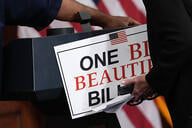You have /5 articles left.
Sign up for a free account or log in.
New York Governor Andrew Cuomo wants to bring professors back into prisons 20 years after Congress and one of his predecessors cut funding for inmate higher education.
Congress and the Clinton administration ended Pell Grant funding for prisoners in 1994, effectively cutting off funds for most college education in prisons. New York followed suit a year later and made sure its inmates couldn’t get funding from the state’s Tuition Assistance Program either.
Now, Cuomo has proposed a plan -- drawing fire from many -- that he says will save money by giving prisoners a better chance to find jobs and stay out of trouble once they are released.
The federal and state moves in the 1990s left many prisons without any higher education offerings, except for relatively small programs offered by private groups. Cuomo's plan is an unusual effort by a powerful politician to put real money into college programs behind bars.
"We’re imprisoning. We’re isolating. But we’re not rehabilitating the way we should,” Cuomo said this month when he announced the plan to a church gathering of the state’s Black, Puerto Rican, Hispanic and Asian Legislative Caucus. “We’re not correcting the way we should. We’re not improving the way we should.”
The governor wants to better-prepare prisoners for life after jail and cut New York’s recidivism rate of 40 percent, which is still below the national average.
Opponents of the plan, including state lawmakers with prisons in their districts, say law-abiding New Yorkers can barely afford college while the governor is trying to give a free education to the state’s crooks.
“Rewarding criminal behavior with free college education reinforces their actions and makes them smarter criminals,” Assemblyman James Tedisco, a Republican, said in a statement. “This is definitely ‘Breaking Bad’ by potentially turning a bunch of Jesse Pinkmans into Walter Whites – all on the taxpayer’s dime.”
Details of the plan will become clearer on Monday, when the governor's office is expected to ask higher ed institutions to submit proposals for the plan. Cuomo’s initial goal is to provide a college education in 10 of the state’s 70 prisons.
The governor hasn’t said how much the plan will cost or where the money would come from, but one cost estimate is about $5 million a year. It takes about $5,000 a year to educate a prisoner, and about 100 prisoners enroll per prison, said Rob Scott, the director of Cornell University’s prison education program. By contrast, it costs New York about $60,000 to keep a prisoner behind bars.
“You could run this whole thing for about the cost of incarcerating 100 people,” Scott said.
Still, critics of the plan have played on concerns about student debt.
Greg Ball, a state senator, started petition called “Hell No To Attica University: No Free College Education for Convicts,” a reference to the site of a famous prisoner revolt. One of the demands of the Attica prisoners was for better education.
Glen Martin, an activist with JustLeadershipUSA, a nonprofit that wants to cut the American prison population in half by 2030, said critics of Cuomo’s plan are trying to protect jobs in their districts.
The critics, he said, are “mostly conservative Senate Republican from upstate districts that rely on prisons as economic engines and have corrections officers as part of their constituents.”
Critics of Cuomo have accused him of playing politics, too.
An editorial in The Staten Island Advocate said the governor was trying to outfox New York City’s populist mayor, Bill DeBlasio, who has been urging the fiscally conservative governor to fund an expansive universal pre-Kindergarten program. Cuomo has “done the mayor one better” with the prison education program, the paper’s editors said. The program could also appeal to minority voters without costing much, if the several million dollar price tag is accurate.
Since 2011, Cuomo has been critical of the state’s expensive corrections program, which cost $2.9 billion last year. In that year’s State of the State, he criticized the view that prison facilities should be used as economic development in the depressed regions of the state. “An incarceration program is not an employment program,” he said.
The appetite for providing college educations to prisoners dried up in Congress in the 1994 when Kay Bailey Hutchison, then a Republican Senator from Texas, backed a plan that made felons ineligible for the Pell Grant. In 1995, New York Governor George Pataki, a Republican, made sure state prisoners couldn’t get state financial aid either.
Immediately, prisoner education programs shriveled up.
A few handfuls of programs are operating. Scott said that Cornell’s program tried to put together a national directory of prison programs, but people said they didn’t want to be discovered. That’s in part because of what happened, Scott said, to a program in Indiana that operated under the radar but then was shut down.
New York happens to have several privately funded prisoner education programs, including Cornell’s, the Consortium of the Niagara Frontier and the Bard Prison Initiative.
Max Kenner, the founder of the Bard College program, said the private programs are all fragile and unsustainable without public funding. “Every week is an existential crisis and the governor’s proposal would not only expand on what we do, but make what we do continue to exist,” he said. “Frankly, without the government, this work is a temporary Band-Aid and really cannot continue.”
Advocates say the programs can not only help prisoners prepare for life after they are released, but help control behavior inside prisons. Only prisoners with good behavior are allowed to enroll and stay in the programs, and the inmates in the college programs can also serve as models for other prisoners.
It’s not clear which institutions would get involved if Cuomo’s program were to be funded, but both private colleges and publics are interested.
A spokesman for the State University of New York system said the governor’s plan was in line with the system’s mission.
“SUNY supports the education of more New Yorkers so they can find jobs, be good citizens, and contribute to society,” system spokesman David Doyle said in an email. If the plan is approved, he said, the system believes New York could become a national model.




